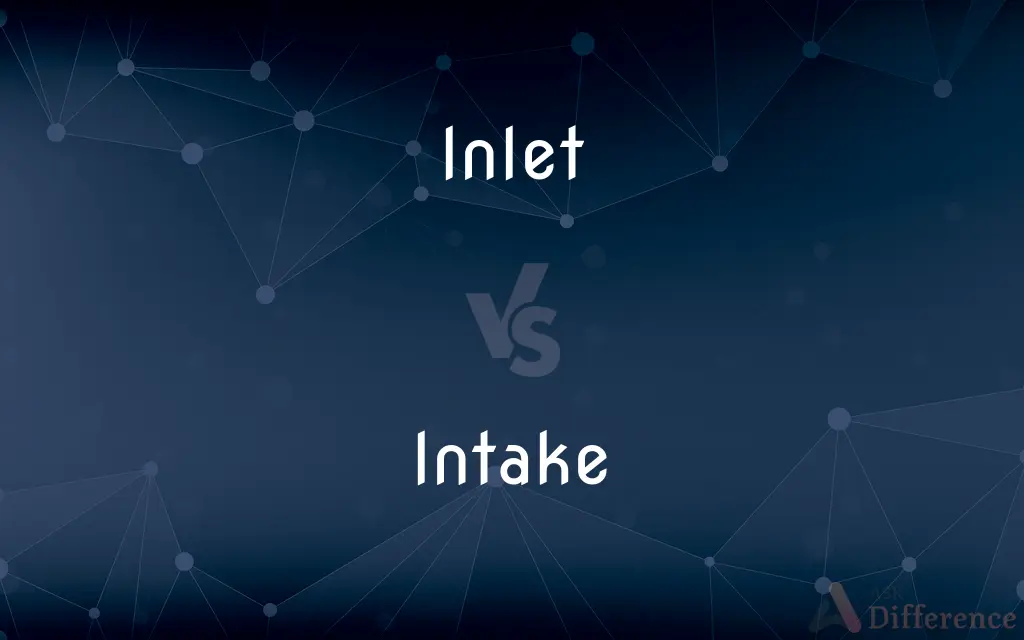Inlet vs. Intake — What's the Difference?
By Fiza Rafique & Urooj Arif — Updated on April 5, 2024
An inlet is a natural or artificial entrance of water from a sea, lake, or river, while intake refers to the act or place where substances are taken in.

Difference Between Inlet and Intake
Table of Contents
ADVERTISEMENT
Key Differences
Inlets are often natural geographical features that allow water to flow from a larger body of water into a smaller one, such as a bay, estuary, or river mouth. They are characterized by their natural formation and can be important for marine navigation and local ecosystems. On the other hand, intake often refers to the process or location where fluids, air, or other substances are taken into a system, device, or organism. It is a term widely used in various fields, including engineering, biology, and environmental science, to describe the entry point of resources or materials.
While inlets are primarily associated with water bodies and can serve as habitats for various forms of wildlife, they can also influence local climates and water quality. Intake mechanisms or structures, however, are designed to draw in specific substances for a particular purpose, such as water intake for irrigation or air intake for combustion engines. These are often man-made and tailored to suit specific operational requirements.
Inlets can also act as gateways for ships and boats, connecting the open sea with ports or inland waterways. This navigational role is crucial for trade, transportation, and access to sheltered waters. In contrast, intakes are crucial in mechanical and biological systems for ensuring the continuous supply of necessary materials or substances, like oxygen intake in humans or water intake for cooling systems in industrial plants.
The formation and function of inlets can be affected by natural processes such as erosion, sediment deposition, and sea level changes. These changes can alter an inlet's depth, width, and accessibility over time. Intake systems, however, must be carefully designed, maintained, and sometimes adjusted to prevent blockages, ensure efficiency, and protect against environmental impacts.
In environmental and ecological studies, the preservation of inlets is often a focus due to their role in supporting biodiversity and their vulnerability to pollution and human development. In contrast, the management of intake processes and structures focuses on optimizing efficiency, reducing environmental harm, and ensuring the sustainability of resource use.
ADVERTISEMENT
Comparison Chart
Definition
A natural or artificial entrance of water from a larger body into a smaller one.
The act or place where substances are taken into a system.
Primary Association
Water bodies such as seas, lakes, and rivers.
Systems or organisms requiring the entry of substances.
Function
Facilitates water flow and access for navigation.
Draws in specific substances for various purposes.
Formation
Often natural, can be influenced by geographical changes.
Usually man-made, designed for specific requirements.
Environmental Impact
Can support biodiversity and affect local climates.
Focuses on efficiency and minimizing ecological disruptions.
Compare with Definitions
Inlet
Man-made channel.
The constructed inlet provides water to the town's reservoir.
Intake
Consumption rate.
Monitoring daily water intake is important for health.
Inlet
Natural entrance.
The scenic inlet allowed small boats to enter the serene lake from the sea.
Intake
Process of taking in.
The intake of air into the lungs is essential for breathing.
Inlet
Navigation route.
Mariners use the inlet to access the port safely.
Intake
Entry point.
The water intake pipes are crucial for the city's supply system.
Inlet
Ecosystem support.
The inlet is home to diverse marine species.
Intake
Mechanical component.
The engine's air intake must be clear of debris for optimal performance.
Inlet
Climate influencer.
The inlet plays a crucial role in the local climate by moderating temperatures.
Intake
Environmental consideration.
The design of the fish intake screen minimizes harm to aquatic life.
Inlet
An inlet is an indentation of a shoreline, usually long and narrow, such as a small bay or arm, that often leads to an enclosed body of salt water, such as a sound, bay, lagoon, or marsh.
Intake
An intake (also inlet) is an opening, structure or system through which a fluid is admitted to a space or machine as a consequence of a pressure differential between the outside and the inside. The pressure difference may be generated on the inside by a mechanism, or on the outside by ram pressure or hydrostatic pressure.
Inlet
A small arm of the sea, a lake, or a river.
Intake
An opening by which a fluid is admitted into a container or conduit.
Inlet
A place or means of entry
An air inlet
Intake
The act of taking in.
Inlet
(chiefly in tailoring and dressmaking) a piece of material inserted into a garment.
Intake
The quantity taken in.
Inlet
A recess, such as a bay or cove, along a coast.
Intake
Something, especially energy, taken in.
Inlet
A stream or bay leading inland, as from the ocean; an estuary.
Intake
The place where water, air or other fluid is taken into a pipe or conduit; opposed to outlet.
Inlet
A narrow passage of water, as between two islands.
Intake
The beginning of a contraction or narrowing in a tube or cylinder.
Inlet
A drainage passage, as to a culvert.
Intake
The quantity taken in.
The intake of air
Inlet
An opening providing a means of entrance or intake.
Intake
An act or instance of taking in.
An intake of oxygen or food
Inlet
(transitive) To let in; admit.
Intake
The people taken into an organisation or establishment at a particular time.
The new intake of students
Inlet
(transitive) To insert; inlay.
Intake
The process of screening a juvenile offender to decide upon release or referral.
Inlet
(firearms) To carve the wooden stock of a firearm so as to position the metal components in it.
Intake
A tract of land enclosed.
Inlet
A body of water let into a coast, such as a bay, cove, fjord or estuary.
Intake
Any kind of cheat or imposition; the act of taking someone in.
Inlet
A passage that leads into a cavity.
Intake
To take in or draw in; to bring in from outside.
Inlet
A passage by which an inclosed place may be entered; a place of ingress; entrance;
Doors and windows, inlets of men and of light.
Intake
The place where water, air, or other substance is taken into a pipe, conduit, or machine; - opposed to outlet.
Inlet
A bay or recess, as in the shore of a sea, lake, or large river; a narrow strip of water running into the land or between islands.
Intake
The beginning of a contraction or narrowing in a tube or cylinder.
Inlet
That which is let in or inlaid; an inserted material.
Intake
The quantity taken in; as, the intake of air.
Inlet
An arm off of a larger body of water (often between rocky headlands)
Intake
The process of taking food into the body through the mouth (as by eating)
Intake
An opening through which fluid is admitted to a tube or container
Common Curiosities
Can inlets be man-made?
Yes, inlets can be artificially created for navigation, water management, or environmental restoration purposes.
Why are inlets important for marine navigation?
Inlets serve as navigational passages for ships and boats to access ports, bays, and inland waterways from larger bodies of water.
What is an inlet in geography?
An inlet is a narrow body of water between islands or leading inland from a larger body of water, often leading to an estuary or a bay.
How do natural processes affect inlets?
Natural processes like erosion, sedimentation, and sea-level changes can alter the shape, size, and function of inlets over time.
What role do inlets play in coastal ecosystems?
Inlets provide habitats for wildlife, facilitate nutrient exchange, and can act as buffers against storms and erosion.
How is water intake regulated for environmental protection?
Water intake is regulated through laws and technologies that minimize ecological impact, such as fish screens and intake velocity restrictions.
How do inlets affect the environment?
Inlets can support diverse ecosystems, influence local climates, and affect water quality in surrounding areas.
What is the purpose of an intake in engineering?
In engineering, an intake is designed to draw in air, water, or other substances necessary for the operation of machines or systems.
How does intake efficiency impact system performance?
Efficient intakes ensure optimal performance of mechanical and biological systems by providing a steady, clean supply of necessary substances.
What challenges are associated with maintaining inlets?
Challenges include managing sediment, preventing pollution, and adapting to changing environmental conditions.
What are common uses of intake structures?
Intake structures are used for water supply, cooling systems in industrial plants, and air supply in combustion engines.
What factors influence the design of intake systems?
Factors include the type of substance to be drawn in, environmental regulations, efficiency requirements, and prevention of blockages.
How can intake processes be made more environmentally friendly?
This can be achieved through better design, use of environmentally safe materials, and technologies that minimize harmful impacts.
How is the air intake important for vehicle engines?
The air intake system ensures that the engine receives enough air for fuel combustion, affecting performance and efficiency.
Are there any risks associated with water inlets?
Risks include pollution, sediment accumulation, and changes in water flow that can impact local ecosystems and water quality.
Share Your Discovery

Previous Comparison
Visited vs. Went
Next Comparison
Detente vs. RapprochementAuthor Spotlight
Written by
Fiza RafiqueFiza Rafique is a skilled content writer at AskDifference.com, where she meticulously refines and enhances written pieces. Drawing from her vast editorial expertise, Fiza ensures clarity, accuracy, and precision in every article. Passionate about language, she continually seeks to elevate the quality of content for readers worldwide.
Co-written by
Urooj ArifUrooj is a skilled content writer at Ask Difference, known for her exceptional ability to simplify complex topics into engaging and informative content. With a passion for research and a flair for clear, concise writing, she consistently delivers articles that resonate with our diverse audience.















































